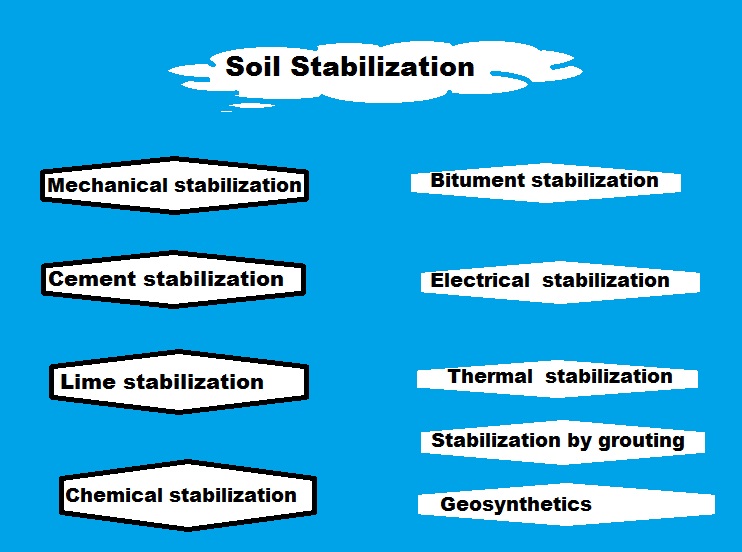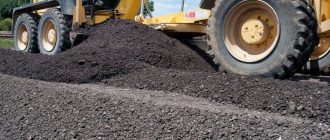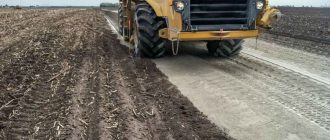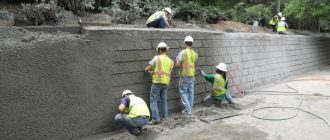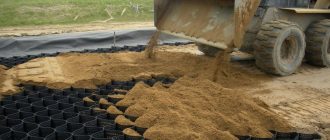
Comparing Chemical vs. Mechanical Soil Stabilization Techniques
Soil stabilization is a crucial process in construction and engineering projects to ensure the durability and strength of foundations and structures. There are various techniques available to stabilize soil, such as mechanical and chemical methods. Each technique has its own pros and cons, and understanding these differences is essential in determining the most suitable approach for a particular project.
Mechanical soil stabilization involves the use of physical means to improve the properties of soil. This technique often includes processes like compaction, mixing, and reinforcement. Mechanical stabilization techniques rely on the addition of materials like stone, gravel, or geotextiles to enhance the soil’s load-bearing capacity and prevent settlement. While mechanical techniques are generally cost-effective and have proven track records, they may be limited in their effectiveness for certain soil types or conditions.
Chemical soil stabilization, on the other hand, involves the use of chemical additives to alter the soil’s properties and improve its stability. Common chemical stabilizers include lime, cement, and fly ash. These additives react with the soil particles, making them more cohesive and less susceptible to erosion. Chemical stabilization can be particularly effective for clayey soils or areas with high water content. However, it may require more time and resources for mixing and curing, and the long-term environmental impacts of these chemicals should be carefully considered.
In conclusion, both mechanical and chemical soil stabilization techniques offer viable solutions for enhancing soil stability. Mechanical methods provide a cost-effective approach that is widely applicable, while chemical techniques offer targeted improvements for specific soil conditions. The choice between the two ultimately depends on factors such as the project requirements, soil characteristics, and environmental considerations. By carefully evaluating the pros and cons of each technique, engineers and contractors can select the most appropriate soil stabilization approach for their projects.
Benefits of Chemical Soil Stabilization
When comparing soil stabilization techniques, it is important to consider the benefits of chemical stabilization. Chemical soil stabilization offers several advantages over mechanical techniques:
1. Cost-effective: Chemical stabilization techniques can be more cost-effective compared to mechanical methods. Using chemicals to stabilize soil can reduce the need for extensive excavation and grading, which can save both time and money.
2. Versatility: Chemical soil stabilization techniques can be used in a variety of soil types and conditions. Whether the soil is sandy, clayey, or a mixture of both, chemical stabilization can be an effective solution. This versatility allows for greater flexibility in project planning and execution.
3. Increased stability: Chemical stabilization can significantly improve the stability of soil. By binding the soil particles together, chemical additives create a stronger and more cohesive soil matrix. This increased stability can help prevent soil erosion, improve load-bearing capacity, and reduce settlement.
4. Enhanced durability: Chemical stabilization can also enhance the durability of soil. By strengthening the soil structure, chemical additives can improve resistance to environmental factors such as water infiltration, freeze-thaw cycles, and chemical degradation. This can extend the lifespan of the stabilized soil and reduce maintenance requirements.
5. Environmental-friendly: Chemical stabilization techniques often use environmentally friendly additives that are non-toxic and biodegradable. This reduces the environmental impact of the stabilization process and minimizes potential harm to ecosystems and water sources.
In conclusion, chemical soil stabilization techniques offer several benefits compared to mechanical methods. They are cost-effective, versatile, increase stability and durability, and are environmentally friendly. These advantages make chemical stabilization an attractive option for various soil stabilization projects.
Advantages of Mechanical Soil Stabilization
Mechanical soil stabilization offers a number of advantages over chemical stabilization techniques. Here are some key benefits:
1. Cost-effective: Mechanical soil stabilization is often more cost-effective when compared to chemical stabilization. The equipment and techniques used for mechanical stabilization are generally more affordable and readily available, resulting in lower overall project costs.
2. Environmental considerations: Unlike chemical stabilization, mechanical stabilization does not involve the use of potentially harmful chemicals. This makes it a more environmentally friendly option, as there is minimal risk of chemical leaching or contamination.
3. Flexibility: Mechanical soil stabilization techniques can be applied to a wide range of soil types and conditions. Whether dealing with clay, silt, or sand, mechanical methods can be tailored to meet specific project requirements.
4. Longevity: Mechanical soil stabilization can provide long-term stabilizat
Limitations of Chemical Soil Stabilization
Mechanical soil stabilization techniques have long been used in construction to improve soil strength and stability. However, chemical soil stabilization techniques have emerged as an alternative method that offers several advantages. Despite these advantages, it is important to note that chemical soil stabilization also has its limitations.
1. Limited applicability: Chemical soil stabilization techniques may not be suitable for all types of soil. Certain soil compositions or conditions may not react well to the chemicals used, making it ineffective in improving soil stability.
2. Cost: Chemical soil stabilization can be more expensive compared to mechanical techniques. The cost of chemicals and specialized equipment required for the process can add up, increasing the overall project expenses.
3. Environmental impact: The use of chemicals in soil stabilization can have environmental implications. Some chemicals used may be toxic or harmful to the natural ecosystem, requiring careful handling and disposal procedures to mitigate their impact.
4. Long-term durability: While chemical soil stabilization can provide immediate improvements to soil strength, the long-term durability of the stabilization may be a concern. Factors such as weathering, erosion, and moisture content can affect the effectiveness of the chemical stabilization over time.
5. Time-consuming process: Chemical soil stabilization typically requires a longer application and curing time compared to mechanical techniques. This can lead to delays in construction schedules, especially if the project requires quick stabilization of the soil.
Despite these limitations, chemical soil stabilization techniques continue to be used successfully in many construction projects. It is important to carefully assess the soil conditions and project requirements to determine the most appropriate soil stabilization technique to ensure the desired results.
Disadvantages of Mechanical Soil Stabilization
Mechanical soil stabilization techniques, while effective in certain situations, also have their disadvantages compared to chemical methods.
One major drawback is the potential for damage to the existing soil structure. The process of mechanical stabilization involves the manipulation and compaction of soil, which can lead to a loss of natural soil characteristics and reduce its ability to handle load-bearing demands. This can result in increased settlement and decreased stability over time.
Additionally, mechanical techniques often require heavy machinery and equipment, which can be costly to purchase or rent. This can make mechanical stabilization less financially feasible for smaller projects or budget-conscious organizations.
Furthermore, the effectiveness of mechanical stabilization is highly dependent on the quality and composition of the existing soil. If the soil is too soft or contains too much moisture, it may not be suitable for mechanical stabilization methods. In these cases, alternative techniques such as chemical soil stabilization may be more effective.
Lastly, the use of mechanical techniques can be disruptive to the surrounding environment and communities. The noise, vibrations, and potential dust generation associated with mechanical stabilization can impact nearby residents and ecosystems. This can lead to complaints, environmental concerns, and potentially even legal issues.
In conclusion, while mechanical soil stabilization techniques have their advantages, including cost-effectiveness and versatility, they also come with several disadvantages that need to be carefully considered and weighed against alternative options such as chemical stabilization.
Cost Considerations for Chemical Soil Stabilization
When comparing the cost of chemical soil stabilization techniques to mechanical stabilization techniques, several important factors must be taken into consideration.
Firstly, the initial cost of chemical stabilization can be higher than that of mechanical techniques. Chemical stabilizers can be expensive to purchase, especially if large quantities are required to treat a large area of soil. Additionally, specialized equipment may be needed to apply the chemicals effectively, which can further increase the upfront cost.
However, it is important to note that the long-term cost benefits of chemical soil stabilization may outweigh the initial investment. Chemical stabilization techniques have been shown to have a longer lifespan compared to mechanical stabilization techniques. This means that once the soil is treated with chemicals, it is less likely to require frequent maintenance or reapplication. In contrast, mechanical stabilization techniques may need periodic repairs or additional measures to maintain their effectiveness, which can add to the overall cost over time.
Another cost consideration for chemical soil stabilization is the potential for environmental contamination. Some chemical stabilizers may have harmful effects on the environment and require careful handling and disposal. This can incur additional costs for proper storage, transportation, and disposal of the chemicals, as well as potential cleanup expenses in the event of a spill or leakage.
Finally, the overall cost of chemical stabilization techniques can vary depending on the specific needs and conditions of the soil being treated. Factors such as the type and extent of soil improvement required, the availability and cost of suitable chemical stabilizers, and the expertise and labor required for application can all impact the total cost. It is essential for project planners and engineers to carefully evaluate these factors and consider the cost implications before deciding on the most suitable stabilization technique for a given soil project.
| Initial Cost | Higher | Lower |
| Long-Term Cost | Lower (less maintenance, longer lifespan) | Higher (periodic repairs, additional maintenance) |
| Environmental Costs | Additional costs for handling and disposal | Minimal |
| Overall Cost Variations | Dependent on soil conditions, chemical availability, and expertise | Dependent on soil conditions and required mechanical measures |
Cost Considerations for Mechanical Soil Stabilization
When comparing mechanical and chemical techniques for soil stabilization, one important factor to consider is the cost.
Mechanical soil stabilization techniques typically involve the use of heavy machinery, such as graders, compactors, and pavers. These machines can be expensive to purchase or rent, depending on the duration of the project. Additionally, the cost of fuel, maintenance, and operator wages must be factored in.
On the other hand, chemical soil stabilization techniques often require the use of additives or agents, which can also contribute to the overall cost. These additives may need to be purchased in large quantities and applied at specific rates, depending on the condition and type of soil.
However, it is important to note that the long-term cost of mechanical soil stabilization can often be lower than that of chemical techniques. Mechanical stabilization can improve soil strength and durability, which may reduce the need for ongoing maintenance and repair. Over time, this can result in cost savings.
Ultimately, the cost considerations for mechanical soil stabilization will vary depending on the specific project and its requirements. It is important to carefully analyze the upfront and long-term costs of both mechanical and chemical techniques to determine the most cost-effective solution for a given soil stabilization project.
Environmental Impact of Chemical Soil Stabilization
Chemical soil stabilization techniques are commonly used for improving soil properties in various engineering and construction projects. These techniques involve the use of chemical additives to modify the physical and chemical characteristics of the soil, making it more stable and suitable for construction purposes. While chemical soil stabilization techniques offer several benefits, it is essential to consider their potential environmental impacts.
- Contamination of groundwater: The chemicals used in soil stabilization can potentially leach into the groundwater, leading to groundwater contamination. This contamination can have detrimental effects on the quality of water sources and the surrounding ecosystem.
- Soil degradation: Chemical additives may contribute to soil degradation over time. These additives can alter the biological and chemical properties of the soil, affecting its fertility and natural nutrient cycles. Prolonged use of chemicals can lead to long-term degradation, making the soil less suitable for plant growth.
- Ecological disruption: Chemical soil stabilization techniques can disrupt the natural ecological balance in the surrounding area. The application of chemicals may harm beneficial soil organisms, including microorganisms and earthworms, which play vital roles in soil health and nutrient cycling.
- Air pollution: Certain chemical additives used in soil stabilization may release volatile organic compounds (VOCs) into the air, contributing to air pollution. These VOCs can have adverse health effects on humans and wildlife in the vicinity.
- Non-biodegradable additives: Some chemical additives used in soil stabilization may not be biodegradable, leading to long-term persistence of these chemicals in the environment. This can pose a risk to ecosystems and organisms in the long run.
To mitigate these environmental impacts, it is crucial to carefully select and use chemical additives that have minimal adverse effects on the environment. Additionally, implementing proper waste management practices, such as proper disposal of leftover chemicals, can help reduce the environmental footprint of chemical soil stabilization techniques.
Environmental Impact of Mechanical Soil Stabilization
Mechanical soil stabilization techniques have several environmental considerations that should be taken into account when comparing them to chemical soil stabilization techniques.
One of the main environmental impacts of mechanical soil stabilization is the disturbance to the natural habitat and ecosystem. When mechanical equipment is used to stabilize the soil, it often requires heavy machinery and excavation, which can lead to the destruction of vegetation and the disruption of animal habitats. This can have long-lasting effects on the local biodiversity and ecosystem balance.
In addition, the noise and vibrations generated by mechanical soil stabilization techniques can have negative effects on nearby wildlife and residents. The loud noise and constant vibrations can disturb animals, causing them stress and potentially affecting their behavior and reproductive patterns. It can also be a nuisance to nearby communities, with the constant noise and vibrations impacting the quality of life for residents in the area.
Furthermore, the energy consumption and emissions associated with mechanical soil stabilization techniques should not be ignored. Heavy machinery requires fuel to run, which contributes to air pollution and greenhouse gas emissions. The extraction and transportation of materials to be used in mechanical stabilization techniques can also have a negative impact on the environment, as it often requires the use of fossil fuels and can contribute to carbon emissions.
Overall, while mechanical soil stabilization techniques may offer certain advantages in terms of cost and time-efficiency, their environmental impact should be carefully considered. The disturbance to the natural habitat, the noise and vibrations, as well as the energy consumption and emissions associated with these techniques, can have significant consequences for the ecosystem and surrounding communities.
Factors to Consider for Choosing the Right Technique
When it comes to stabilizing soil, there are various factors that should be taken into consideration when choosing between chemical and mechanical techniques. Understanding these factors can help determine which method is more suitable for a specific project.
Soil Type: The type of soil being stabilized is an important factor to consider. Chemical techniques, such as soil injection, are more effective in cohesive soils, while mechanical techniques, such as soil compaction, may be better suited for granular soils.
Depth of Stabilization: The depth of stabilization required will also play a role in choosing the right technique. Chemical stabilization can be used to treat deep soil layers, while mechanical techniques are typically limited to surface stabilization.
Cost: Cost is another factor that should be considered. Chemical techniques can be more expensive due to the cost of the chemicals used, while mechanical techniques may require more heavy machinery, resulting in higher operational costs.
Time Constraints: Time is often a critical factor in construction projects. Chemical techniques usually have a quicker curing time, allowing for faster project completion. Mechanical techniques may require longer curing times or additional waiting periods before construction can commence.
Environmental Impact: The environmental impact of the stabilization technique is an important consideration. Chemical techniques can have potential environmental risks, such as contamination of groundwater. Mechanical techniques, on the other hand, are typically considered to have a lower environmental impact.
By considering these factors, engineers and contractors can make an informed decision on whether to use a chemical or mechanical soil stabilization technique, ensuring the success and sustainability of their projects.
Frequently asked questions:
What are the different types of soil stabilization techniques?
There are two main types of soil stabilization techniques: chemical stabilization and mechanical stabilization. Chemical stabilization involves the use of additives such as lime, cement, or fly ash to improve the strength and durability of the soil. Mechanical stabilization, on the other hand, relies on physical methods such as compaction, reinforcement, or drainage to enhance the stability of the soil.
What are the advantages of chemical soil stabilization?
Chemical soil stabilization offers several advantages. Firstly, it can be used on a wide range of soil types, including cohesive and non-cohesive soils. It also provides long-term stability and durability, making it suitable for various applications. Additionally, chemical stabilization can be carried out quickly and efficiently, with minimal disruption to the surrounding environment.
What are the disadvantages of chemical soil stabilization?
While chemical soil stabilization has many benefits, it also has some disadvantages. One major drawback is the potential environmental impact of the additives used. Certain chemicals, such as lime or cement, may have a negative effect on the surrounding ecosystem if not properly managed. Additionally, the cost of chemical stabilization can be higher compared to mechanical stabilization methods.
What are the benefits of mechanical soil stabilization?
Mechanical soil stabilization offers several advantages. Firstly, it is a more cost-effective option compared to chemical stabilization, as it typically requires less materials and labor. Mechanical methods also allow for greater control over the construction process, as adjustments can be made on-site if needed. Moreover, mechanical stabilization techniques, such as compaction or reinforcement, can improve the overall load-bearing capacity of the soil.
What are the limitations of mechanical soil stabilization?
Despite its benefits, mechanical soil stabilization does have some limitations. One limitation is that it may not be suitable for all soil types. Cohesive soils, for example, may require chemical stabilization to achieve the desired results. Additionally, mechanical methods may require more time and effort compared to chemical stabilization, especially for larger-scale projects.
What are the pros and cons of chemical soil stabilization techniques?
Chemical soil stabilization techniques have several advantages, such as improved soil strength and stability, reduced permeability, and increased resistance to erosion. They are also effective in a wide range of soil types and can be applied in both dry and wet conditions. However, chemical stabilization requires the use of chemicals, which can be costly and may have environmental implications. Additionally, the long-term effects of chemical stabilization are not yet fully understood.

